Overview
- Several types of data can be imported through the Import Data screen, such as Product (Inventory), Customer, or Supplier records. Product cost and price information can be imported via this screen as well.
- Data can be imported from:
-
- A tab or comma-delimited text file.
- A table in a Microsoft Access database.
- Any other format (e.g. an Excel spreadsheet or FoxPro table) that can link to an Access database. For information on linking data in external tables to Access, please see MS Access documentation.
- When importing data from a text file, if the data contains commas, the file should be saved as a tab-delimited file, not a CSV.
- Quotes should not be present in text files, regardless of whether it is a CSV or tab-delimited file, or you will encounter errors.
- To access this screen go to one of the following areas:
Main Menu > Manage My Inventory > Import My Inventory – File
Main Menu > Manage My Inventory > Import Cost, Price & Weight
Main Menu > Manage My Inventory > Import My Suppliers
Main Menu > Manage My Customers > Import My Customers – File
- The user is led through the steps to import the various data types by a series of screens.
- This topic discusses the product (inventory) import process.
Other Processes can be found:- Import Cost, Price and Weight – Stone Edge Order Manager
- Import My Suppliers – Stone Edge Order Manager
- Import Supplier Information from a Text File or Database
- Import My Customers – Stone Edge Order Manager
- Import Customer Information from a Text File or Database
Description of the Screens
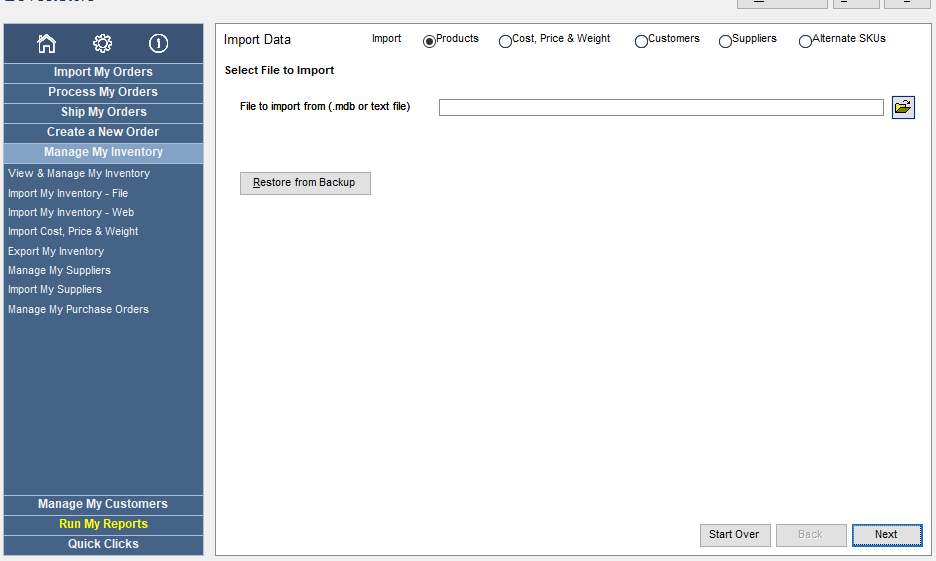
Import Inventory screen: Select the File to Import tab
Select File to Import Tab
Import Radio Button
- The Products radio button is selected by default.
File to import from (.mdb or text file) Field
- Enter the path to the file containing the product information.
- The program displays up to 50 fields in the file and the first 100 records at the bottom of the screen.
Folder Button
- Select this button to navigate to the location of the file containing the product information.
Restore from Backup Button
- Select this button to restore from a previous backup if one was created at the last step of the process.
Start Over Button
- Returns to the Select File to Import tab.
Next Button
- Select this button when ready to proceed to the Import Options tab.
Import Options Tab
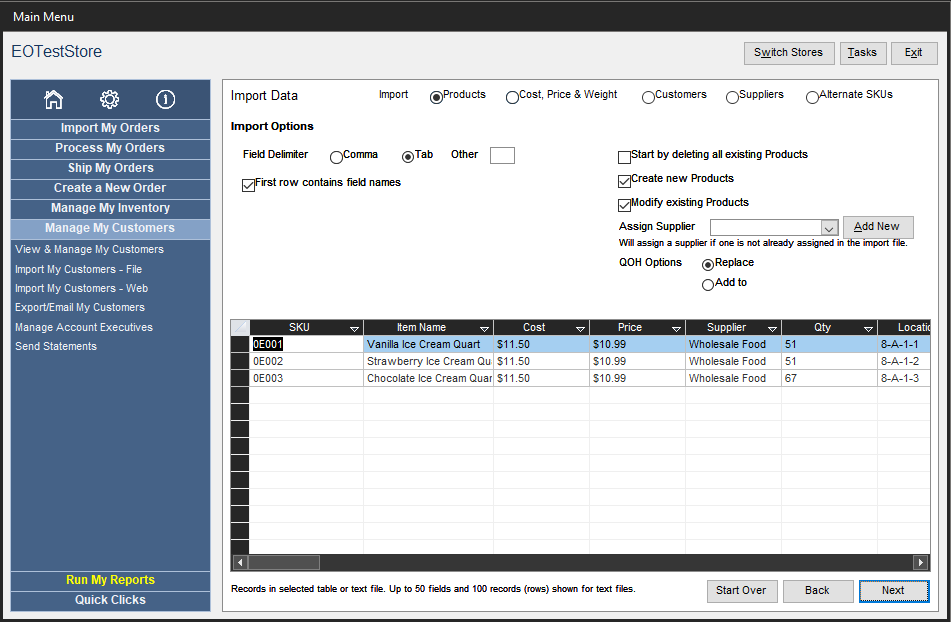
Import Inventory screen: Import Options tab
Field Delimiter Radio Buttons
Comma Radio Button
- Select this button if the fields in the input file are separated by commas.
Tab Radio Button
- Select this button if the fields in the input file are separated by a tab.
Other Field
- Enter the character used to separate the fields in the input file.
The first Row Contains Field Names Check Box
- Select this box if the first row in the input file contains a header record with field names.
Start By Deleting All Existing Products. Check Box
- Select this box to delete all existing product records in the Inventory table before importing the data from the input file.
- If this box is not checked, products that do not already exist are appended to the Inventory table.
Create New Products Check Box
- Select this box to create inventory records for products that do not currently exist (based on the SKU).
- Existing product records may be modified if this is not selected, but no new product records are added.
Modify New Products Check Box
- Select this box to make replace information in existing product records with information from the input file (based on the SKU).
- New product records may be added if this is not selected, but existing product records are not modified.
Assign Supplier Drop-down List
- Select a supplier to assign to product records that do not already contain a Supplier ID or Supplier Name value.
- This supplier automatically becomes the Primary Supplier of the product.
Add New Button
- Click this button to add a new supplier record “on the fly.”
QOH Options Radio Buttons
Replace
- Select this button to replace existing quantity on hand values with those in the input file.
Add to
- Select this button to add the quantity on hand values in the input file to those values in the existing product record.
Data in Text File or Database Table
- This screen section displays up to fifty fields and the first hundred records of data in the input file.
Start Over Button
- Returns to the Select File to Import tab.
Back Button
- Returns to the previous tab.
Next Button
- Select this button when ready to proceed to the Inventory Fields tab.
Inventory Fields Tab – Page 1
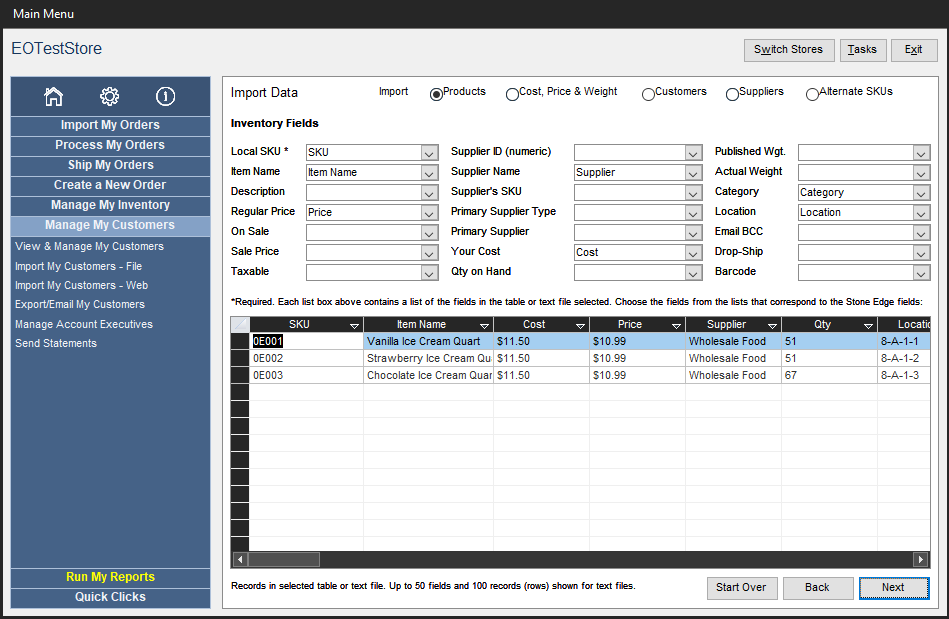
Import Inventory screen: Inventory Fields tab
- Map the fields in the input file to their counterparts in OMS.
- Local SKU is the only required field.
Local SKU Supplier ID Published Weight Item Name Supplier Name Actual Weight Description Supplier’s SKU Category Regular Price Primary Supplier Type Location On Sale Primary Supplier Email BCC Sale Price Your Cost Drop-Ship Taxable Qty on Hand Barcode Data in Text File or Database Table
- This screen section displays up to fifty fields and the first hundred data records in the input file.
Start Over Button
- Returns to the Select File to Import tab.
Back Button
- Returns to the previous tab.
Next Button
- Select this button when ready to proceed to the second page of the Inventory Fields tab.
Inventory Fields Tab – Page 2
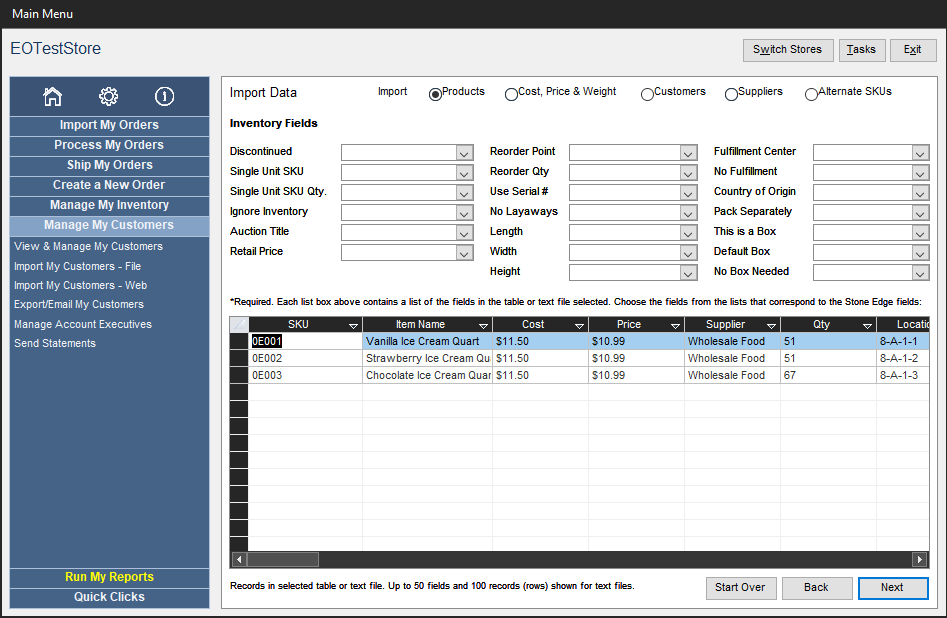
Import Inventory screen: Inventory Fields tab, Page 2
- Continue mapping fields in the input file to those in OMS.
Discontinued Reorder Point Fulfillment Center Single Unit SKU Reorder Qty No Fulfillment Single Unit SKU Qty. Use Serial # Country of Origin* Ignore Inventory No Layaways Pack Separately Auction Title Length This is a Box Retail Price Width Default Box Height No Box Needed * This must be a two-letter abbreviation for the country where the product was produced and used in customs forms.
Data in Text File or Database Table
- This screen section displays up to fifty fields and the first hundred data records in the input file.
Start Over Button
- Returns to the Select File to Import tab.
Back Button
- Returns to the previous tab.
Next Button
- Select this button when ready to proceed to the first page of the Custom Fields tab if custom inventory fields are defined.
Custom Fields Tab – Page 1
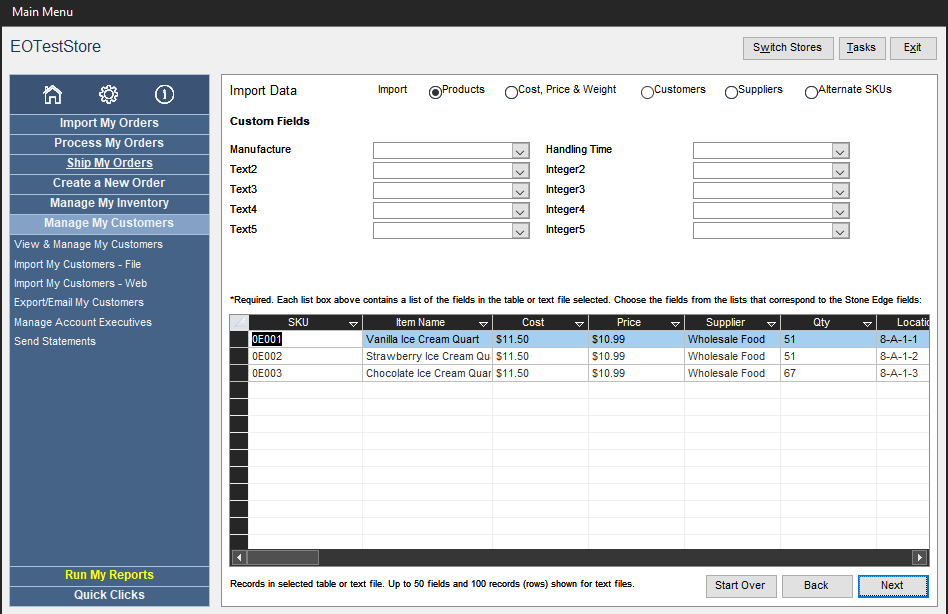
Import Inventory screen: Custom Fields tab
- Map fields in the input file to any custom inventory text or integer fields defined in OMS.
- This tab is not visible if custom inventory fields have not been defined.
Data in Text File or Database Table
- This screen section displays up to fifty fields and the first hundred data records in the input file.
Start Over Button
- Returns to the Select File to Import tab.
Back Button
- Returns to the previous tab.
Next Button
- Select this button when ready to proceed to the second page of the Custom Fields tab if custom inventory fields are defined.
- Map fields in the input file to any custom inventory text or integer fields defined in OMS.
Custom Fields Tab – Page 2
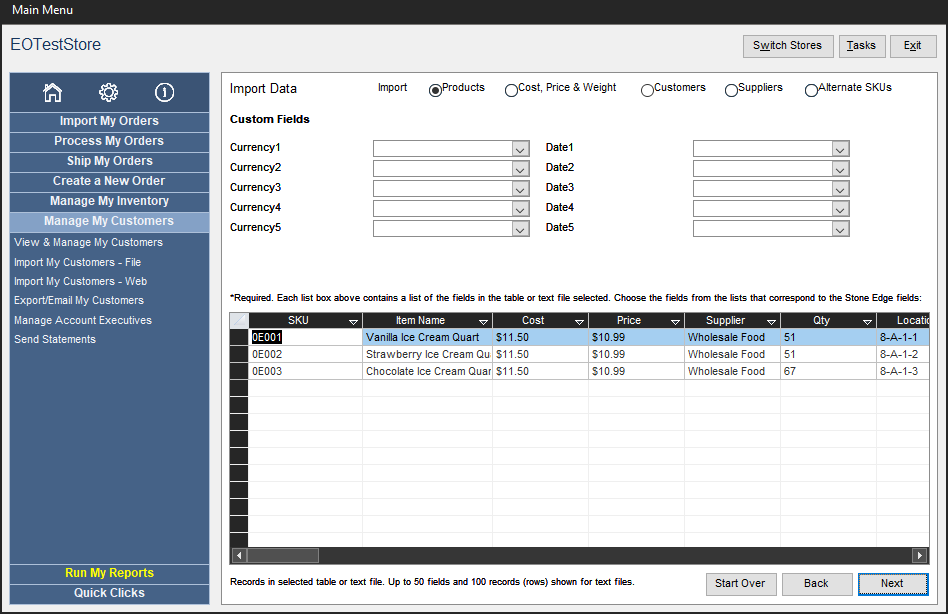
Import Inventory screen: Custom Fields tab, Page 2
- Map fields in the input file to any custom inventory currency or date fields defined in OMS.
- This tab is not visible if custom inventory fields have not been defined.
Data in Text File or Database Table
- This screen section displays up to fifty fields and the first hundred data records in the input file.
Start Over Button
- Returns to the Select File to Import tab.
Back Button
- Returns to the previous tab.
Next Button
- Select this button when ready to proceed to the Web Fields tab.
Web Fields Tab
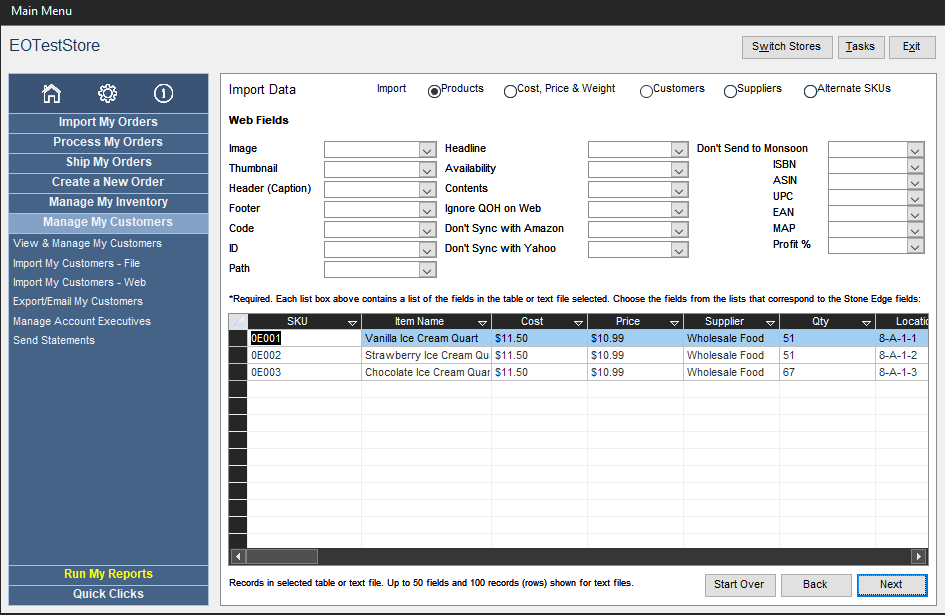
Import Inventory screen: Web Fields tab
- Map fields in the input file to fields in OMS.
- The fields on this screen may not apply to your shopping cart system.
- Refer to the Inventory Knowledge Base topic for more details.
Image Headline Don’t Send to Monsoon Thumbnail Availability ISBN Header Contents ASIN Footer Ignore QOH on Web UPC Code Don’t Sync with Amazon EAN ID Don’t Sync with Yahoo MAP Path Profit % Data in Text File or Database Table
- This screen section displays up to fifty fields and the first hundred data records in the input file.
Start Over Button
- Returns to the Select File to Import tab.
Back Button
- Returns to the previous tab.
Next Button
- Select this button when ready to proceed to the Pricing Fields tab.
Pricing Fields Tab
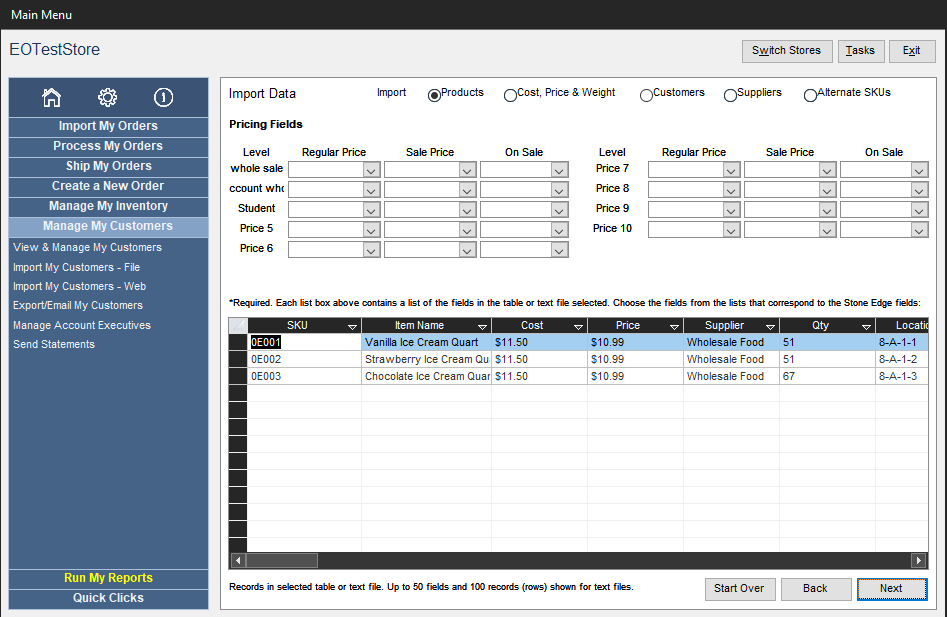
Import Inventory screen: Pricing Fields tab
- Map fields in the input file to fields in OMS.
- The fields on this screen apply to multi-level pricing.
- Refer to the Knowledge Base topic Price Levels for more information.
Data in Text File or Database Table
- This screen section displays up to fifty fields and the first hundred data records in the input file.
Start Over Button
- Returns to the Select File to Import tab.
Back Button
- Returns to the previous tab.
Next Button
- Select this button when ready to proceed to the Finish and Import tab.
Finish and Import Tab
Import Data screen: Finish and Import tab
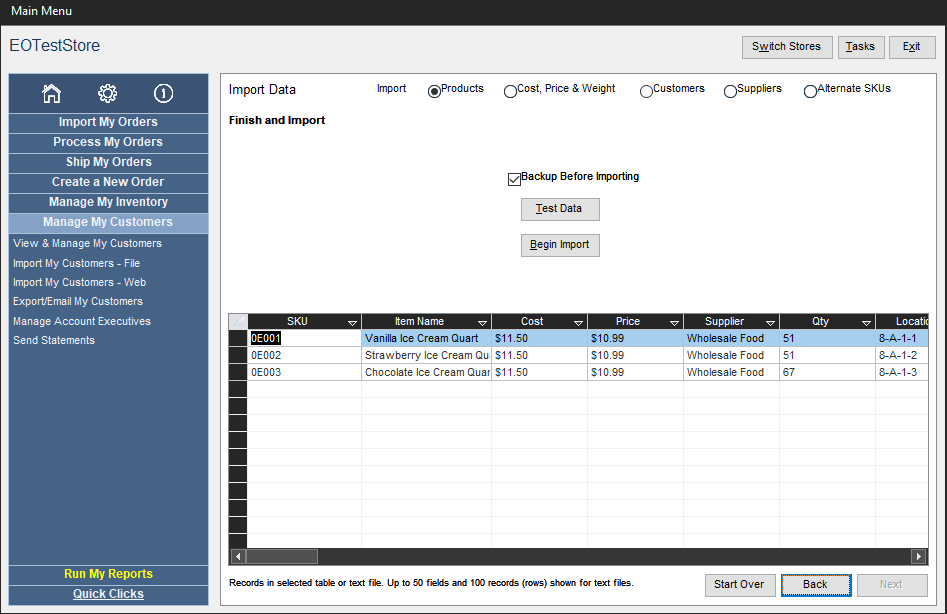
Backup Before Importing Check Box
- Select this box to make a backup copy of the affected tables before the import is started.
Test Data Button
- Select this button to have the program check for errors before starting the import process.
Begin Import Button
- Select this button to start the import process.
Start Over Button
- Returns to the Select File to Import tab.
Back Button
- Returns to the previous tab.
